A good leather jacket can elevate any casual look. But when it comes to buying a leather jacket, there are a lot of styles and colors to consider.
In this article, we will lay out the benefits of a great leather jacket, along with a guide to help you figure out what kind of jacket is right for you.
You will find:
- Why A Leather Jacket?
- Elements Of A Leather Jacket
- The Classic Leather Jacket Styles
- The Motocross
- The Fatigue
- The Bomber
- The Cattleman
- The Duster
- The Bomber
Why a Leather Jacket?
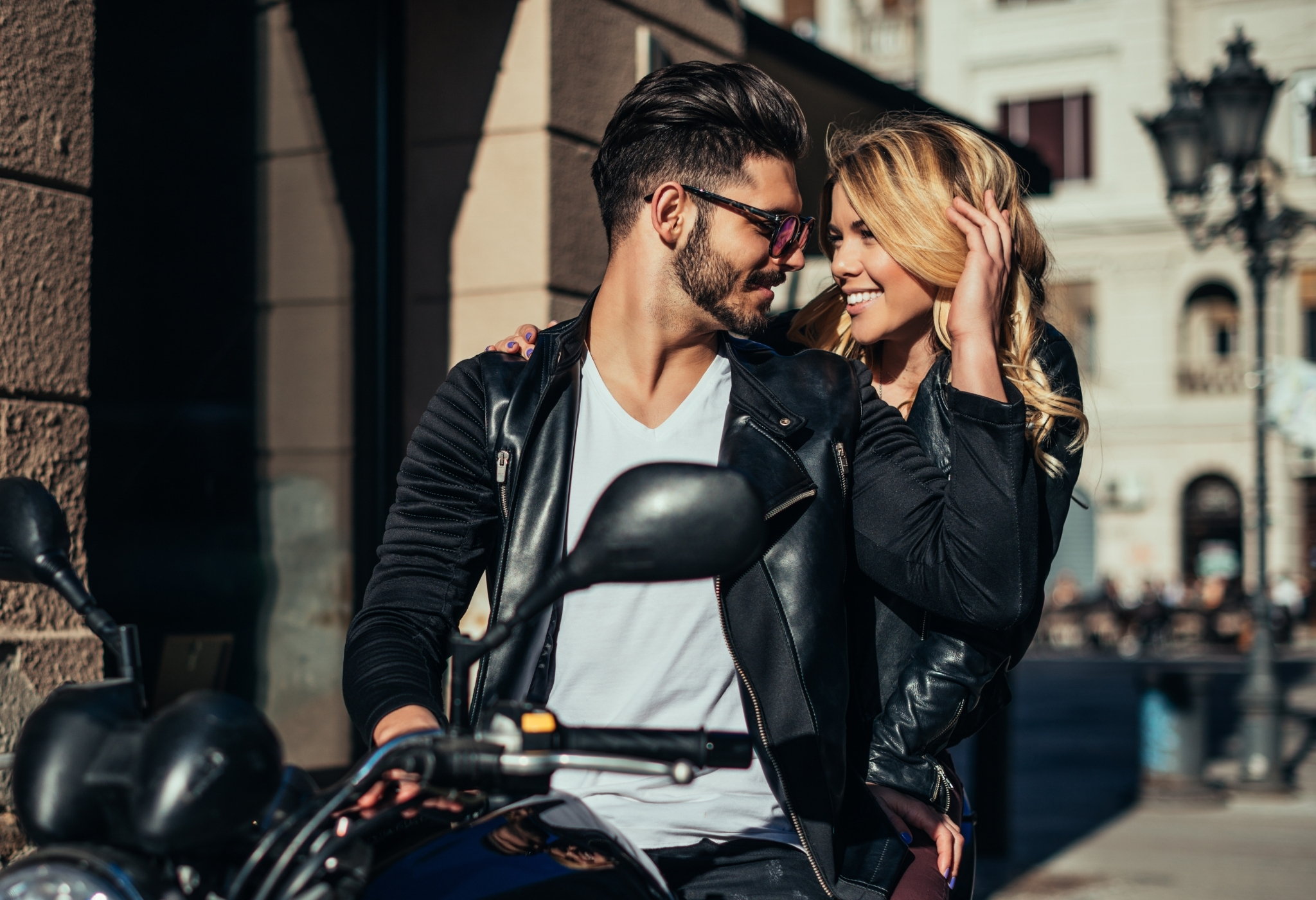
Attitude
Yeah, we’ll go ahead and put this one at the top of the list. You will begin to feel this while you are buying a leather jacket, before even putting it on.
Style, funkiness, class, uniqueness, that bad boy vibe – call it what you want to, but leather has an attitude that cloth doesn’t.
The nice thing about leather is that its tough-guy appeal is timeless, not trendy. We associate leather jackets with ruggedness because people have depended on leather since the early days of humanity. It’s not a constructed image the way that ripped jeans or metal studs are.
So a leather jacket gives its wearer a sense of toughness, competence, and edginess; even when it’s a very smooth and refined jacket style. An attitude that doesn’t try too hard is tough to come by; that’s one of the best reasons to buy a leather jacket and wear one now and again.
Protection
On a much more practical note, leather is tough. Leather hide protects an animal for its whole life. Personal armor has used leather for protection for almost all of human history. That didn't change until the advent of bullet-resistant synthetics in the 20th century.
You’re hopefully never going to need your jacket to turn a knife or protect yourself from a bear’s teeth. But the toughness that protects from those holds up just fine against lesser, day-to-day wear and tear as well. A good leather jacket made from quality hide and treated well should last through all kinds of nicks and scrapes.
The same toughness provides a good level of weather protection as well. Leather is an excellent windbreak and is naturally water-resistant; most jackets these days add waterproofing compounds during the treatment of the hide as well. A leather jacket will still be warm and dry long after wind, rain, or snow have worked their way through the same coat in wool or denim.
Durability

Not quite the same thing as protection, the durability of leather is its natural longevity. Good hide gets more supple as it ages but doesn’t crack or split. If you’re careful about treating it when it needs it, leather can last a lifetime.
It’s worth remembering that we still have leather clothes and armor worn by Roman soldiers in museums worldwide. When you are buying a leather jacket, considering the quality is imperative. If you spend money on a quality product, you can get a leather jacket that will outlive you and your children.
Elements of a Leather Jacket
We’ll get into individual styles and traditional cuts in just a minute here. But before buying a leather jacket, it’s worth familiarizing yourself with the bits and pieces that make up a style so that you can understand why a simple change in the height of the collar and the angle of the pockets can make the difference between a sleek business jacket and a rugged working man’s coat.
Length
The first thing to think about is always the length from top to bottom. The longer the coat is, the more practical it is as a weatherproofing garment, which is why trench coats and dusters are deeply associated with men who work outside. Wearing one of those from your car to your office is a little pretentious.
Most leather jackets are just that – jackets, rather than coats. The bottom hem falls right around the waist. A higher snugger hem is more stylish, while a hem that falls past the belt with a bit of looseness at the hips is a more rugged and outdoorsy look.
It’s oversimplifying a bit, but as a general rule of thumb for stylish jackets, your belt should be visible when you zip your jacket up. If you’re out working with cattle or timber, something longer is fine. When you are buying a leather jacket, be sure to try them on so you can get an idea of the length.
Collars to consider when buying a leather jacket
The shape and size of the collar say a lot about a leather jacket.
Short, tight collars that don’t turn down are associated with fashion and with motorcycles and race cars. They give the sleekest and streamlined look.
A short, soft collar that can either be turned down or popped up to frame the chin is a casual style associated with military surplus and streetwear. That bit of floppiness says “rugged casual.” It’s typical on jackets with a looser cut.
Full turndown collars are typical on rancher jackets, dusters, trenchcoats, and other long leather jackets and coats. The best ones will flip up, and button closed in the rain.
They’re also a defining characteristic of bomber jackets, which are shorter but also meant to be practical, weatherproofing garments because of their aviation history.
Pockets

More pockets are more casual. More details on the pockets are also more relaxed. Logically, that means that your sharpest-looking leather jackets have smooth fronts.
Since that’s not very practical, most fashionable jackets opt for a pair of jetted pockets instead, where the opening is a small slit in the leather without a flap or button. These can be vertical or horizontal, but a vertical or sharply diagonal slit on each side for the hands is typical of jackets seeking a streamlined shape.
More casual jackets add flaps and rotate the pockets to fully horizontal openings. Dressier styles have pockets sewn onto the interior, while more casual ones will have larger “patch” pockets sewn onto the exterior so that the back of the pocket is the front of the jacket.
Anything with more than two pockets on the front is a casual jacket. Four front pockets are very standard for the fatigue style, and dusters and trench coats often have pockets above and below the waist.
Zippers and Buttons

Zippers are sleeker; buttons are chunkier. From a practical standpoint, zippers are also easier to use, while buttons are easier to repair or replace.
There are some contradicting schools of thought on whether a man should wear buttons at all. Leather jackets with big, round buttons have been a feminine style for much of the 20th century; on the other hand, men in both World Wars wore leather jackets with buttons. Many cattlemen still prefer buttons because they pop off when the jacket strains rather than breaking or tearing away from the leather-like zippers.
This shakes down to a cultural divide: sharp-looking urban jackets rarely use buttons, while rugged outdoors jackets use zippers and buttons. You can do whichever you want, but a very sleek and modern-looking jacket with buttons does run the risk of looking a little feminine.
Lapels

There’s very rarely a good reason for a man’s leather jacket to have lapels. They exist, and they appear on the runway regularly enough, but the “leather blazer” look is a tough one to pull off.
If you like the framing effect of lapels – that V-shape widening up your torso, you should look for zippered jackets with wide, soft collars instead. You can wear these half-zipped with the collar flipped out onto the shoulders like a cardigan, giving you the same effect without the awkwardness of a fully-constructed lapel.
For the diehards that must have a constructed lapel, narrow and understated is better. Big flaring lapels on a leather jacket make you look like a low-level Las Vegas mob enforcer or a 1990s superhero. If you get this feeling looking in the mirror while buying a leather jacket, others will to see it too.
Color

Most leather jackets are black or brown. Black works well if your wardrobe has lots of solids and sharp contrasts, while brown works well with a more muted wardrobe that uses many earth tones and textured fabrics.
One of the keys with leather is to match it – you shouldn’t wear a brown jacket with black shoes. If you want to be the kind of guy that wears a leather jacket every day, you’ll probably need two.
Other, brighter colors are available but less versatile. It’s hard to get away with wearing them day in and day out. Avoid racing stripes or other flashy-colored patches unless you’re wearing the jacket to motocross races.
Material to compare when buying a leather jacket
Not all leather is the same leather, or even from the same animal. Different hides with different treatments create several different surfaces for jackets:
- Cowhide is standard, though, and plain. The majority of leather jackets come from it. It’s a thicker, tougher leather that takes a while to break in. Quality can vary widely depending on the animal the leather comes from, which part of the cow the hide comes from, and how the manufacturer treated it. Look for leather that’s thick but not completely stiff on the rack.
- Deerskin is cowhide’s more refined cousin. It’s similarly tough and weatherproof but lighter and more flexible. The finished surface tends to have a softer texture with a bit of knap (fuzz) rather than a slick, sheer feel. It’s suitable for both work jackets and fashion pieces.
- Goatskin comes in and out of fashion. It’s lighter than cowhide and weathers more obviously – a goatskin jacket tends to develop a pattern of surface lines and creases over time, making each unique. It has a more visible texture than cowhide when new.
- Lambskin is soft and sometimes lined with the outer fleece for warmth (though as a practical production reality, most lambskin jackets these days are made of plain leather with fleece stitched back on, which gives you a more even lining than trying to turn a sheep inside-out). It is lighter and softer than most other leathers and is typically light, three-season jackets rather than winter or sporting wear. Lambskin jackets need to be treated a bit more gently than most leather.
- Bison leather is tough, rugged, and textured. As farmed bison become more and more common, the leather is showing up more in stores, especially in protective garments like motorcycle and motocross jackets. Its natural color is ruddy, and the skin has fine creases running throughout it.
As a general rule, cowhide will be the cheapest, but a fancy, upmarket cowhide jacket could easily cost more than a very plain, utilitarian bison jacket. Quality varies widely with all, and a poorly-tanned hide will have a fraction of the longevity of top-notch leather.
The Classic Leather Jacket Styles
Most leather jackets fall into one of a few common families. These common styles all have their niche – wearing a duster to a suit-and-tie meeting will look just as odd as wearing a Prada fatigue jacket to chop wood.
The Motocross Jacket
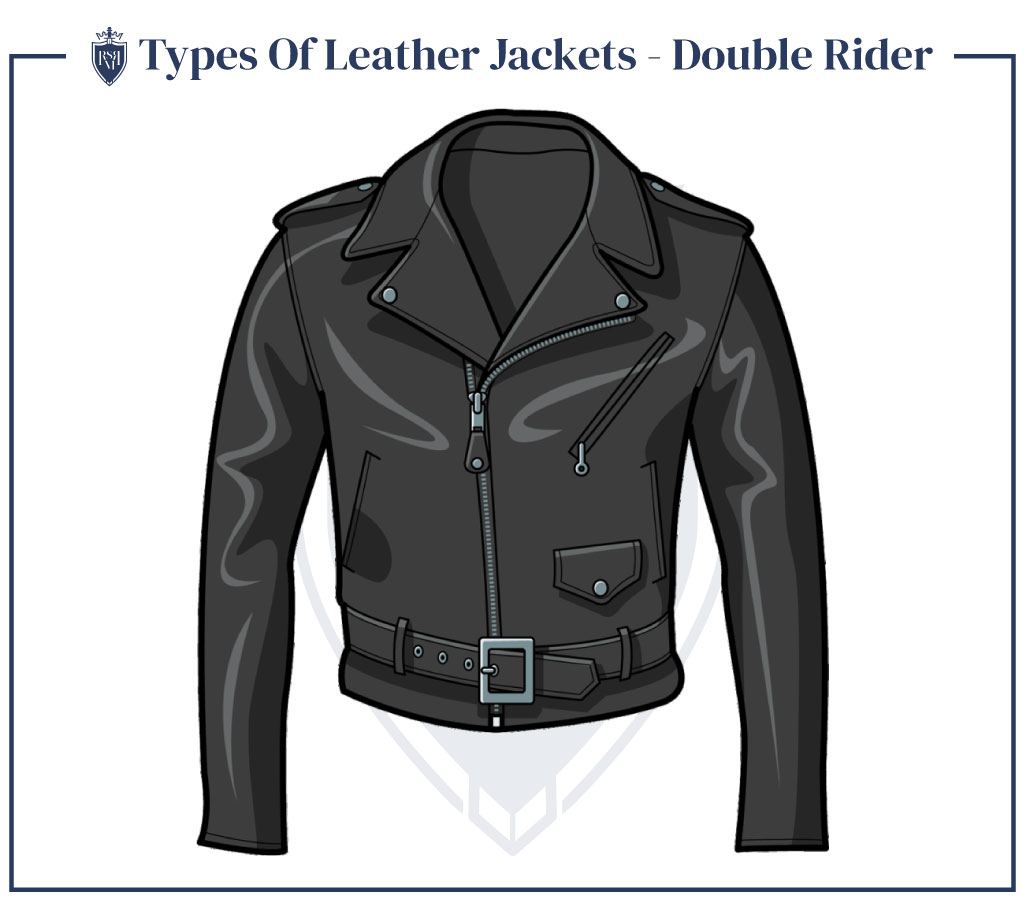
Sometimes called a “moto,” this tight-fitted style has a collar that hugs the neck and doesn’t turn down. The front zips up all the way, and the waist is usually elastic. Since it’s streamlined, there are usually no extra outer details like buckles or pocket flaps.
The moto family of jackets goes well beyond gear for actual motocross riders. It’s one of the most common urban styles for both men and women. It’s simple, sleek, and a bit more dressy than something with lots of bells and whistles.
The tight fit and slim lines make this a good jacket for people with a slender or athletic build. If your midsection is wider than your chest, it’s going to make a noticeable (and unattractive) bulge.
The Fatigue
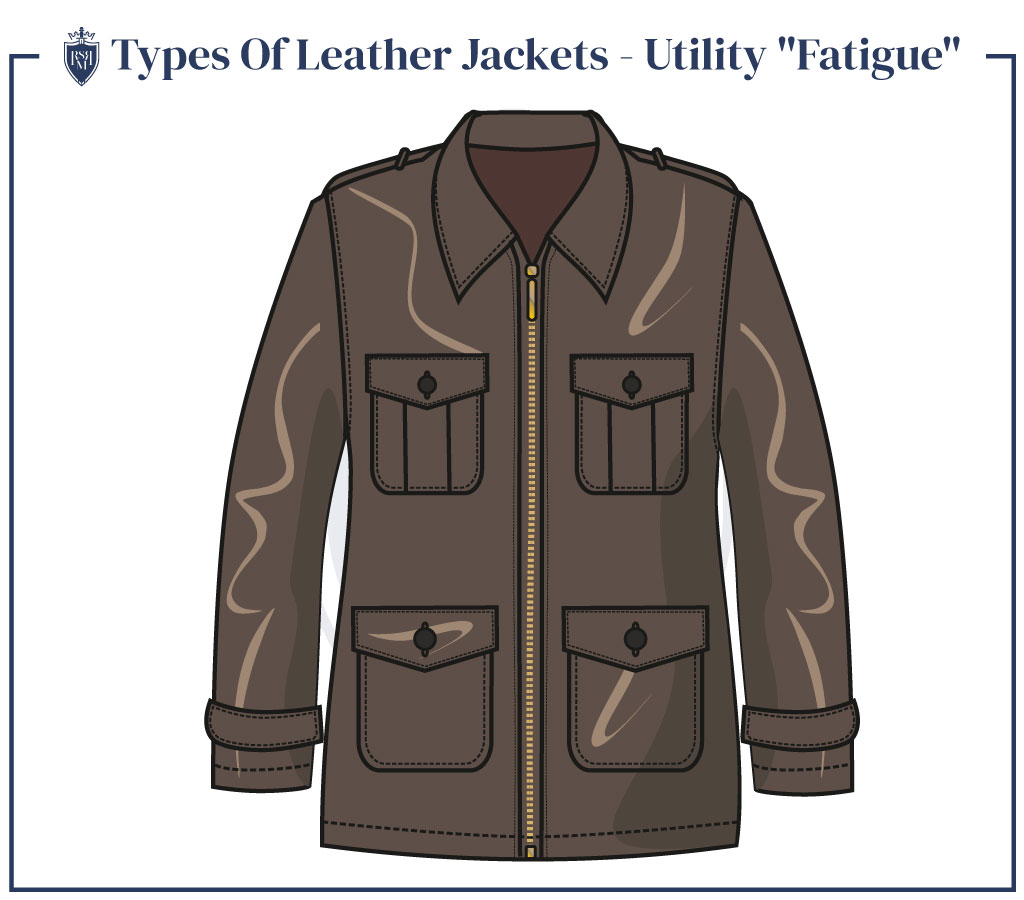
A leather fatigue jacket looks pretty much like a cloth one, except in leather. It has a soft collar that can be turned down or flipped up, horizontally-opening pockets with flaps covering them, and sometimes (though not always) details like a built-in D-ring belt or epaulets. The fit tends to be looser than a moto jacket: it might cinch at the waist if there's a belt built-in, but otherwise, it's a straight up-and-down fit like a sack suit, with no elastic or drawstring at the waist.
Fatigue jackets are practical, utilitarian, and good with just about any day-to-day outfit. They can't dress up quite as sleek as a moto jacket, and they don't offer as much weather protection as a cattleman's jacket or a duster, but they're what most people think of when they think “leather jacket.”
Bigger men look good in a fatigue jacket. The looseness around the waist helps it drape over any thickness in the stomach, and the soft shoulders keep you from looking overstuffed.
The Bomber
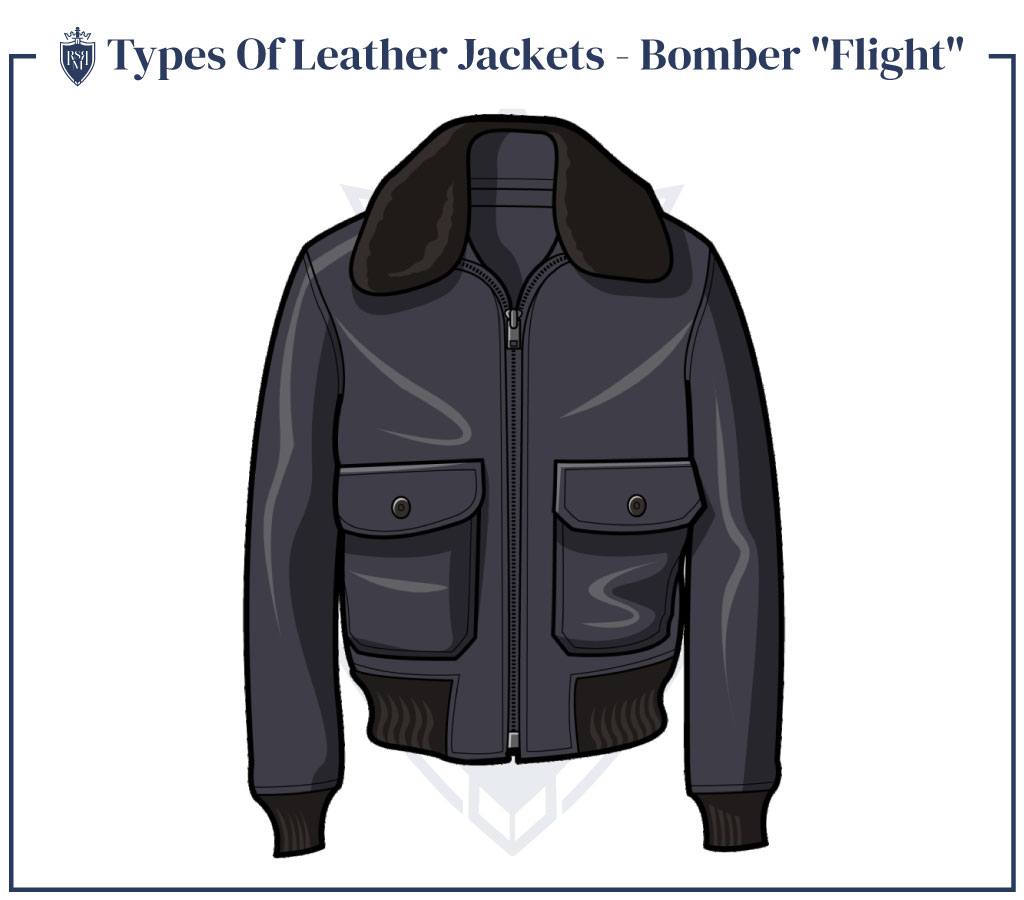
For years, a favorite of vintage junkies and college kids, the bomber tends to get sneered at by high fashion types.
A bomber has a soft, turndown collar with a cloth or fleece lining. It has a lined interior, usually in a heavy, warm fabric (they were made for guys in high-altitude bombers, hence all the warming details). The waist and sleeves cinch tight, usually with elastic and cloth cuffs or with buckles.
Bombers are decidedly more casual than their moto cousins. They share the snug waist and the arm's close fit (a bomber should never wrinkle as it drapes), but the overall style tends to be much more utilitarian, and the fit (because of the thick lining) lessens shapely.
Thin guys can add quite a bit of bulk with a bomber jacket. It has to fit well, though – a loose bomber will swallow you right up. Heavyset guys would do better in a looser style like a fatigue jacket. And as a purely practical note, they should mostly be reserved for fall and winter wear to avoid overheating, making them a bit less versatile than other styles.
The Cattleman
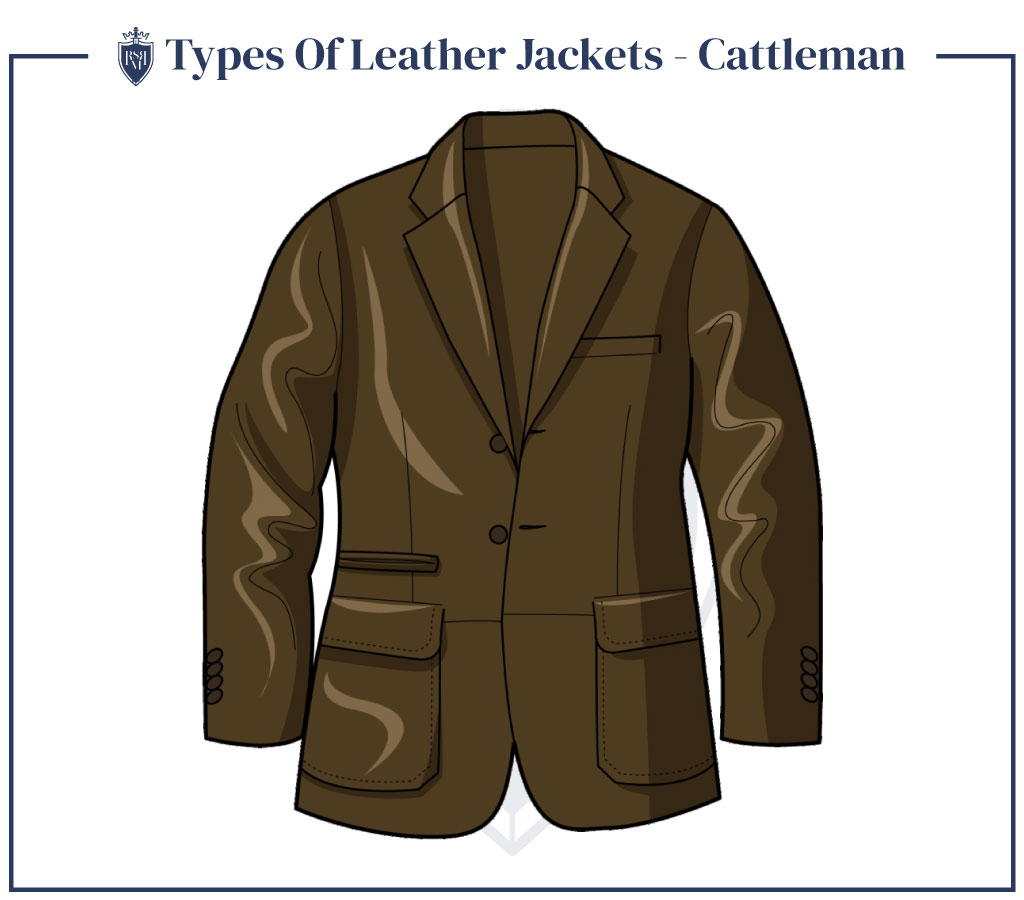
The classic Western-style has seen a lot of adaptation to urban wear lately. In its traditional form, it's a long, straight jacket that flares out slightly at the hips and falls a few inches past the waist. This makes it long enough to protect the weak spot where the shirt meets the trouser from the weather but short enough to wear in the saddle without a pile of leather bunched up around your crotch and butt.
Cattleman coats rarely use any detailing around the edges. The collar is usually a short turndown that can button up against the wind, and the cuffs and waist tend to be plain stitched leather without ahem.
Slimmer versions in light leather are a spring/summer/fall staple in fashion catalogs. More traditional versions made from thick cowhide, deerskin, or bison remain on the racks anywhere that sell farm equipment side-by-side with clothing. It's a good, simple style for people who don't like a lot of bells and whistles and one that works well on shorter men by elongating their torso a bit.
The Duster
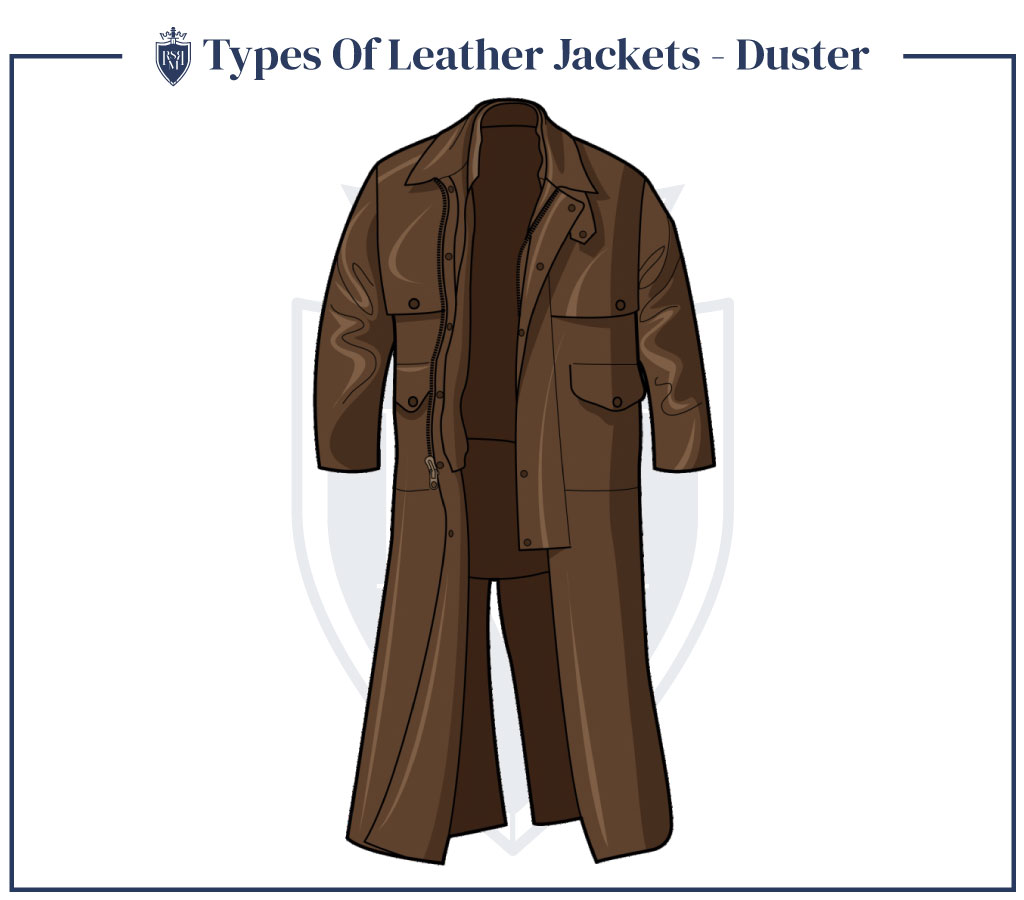
When you are buying a leather jacket, this one can feel a little tricky.
A duster is a full-length coat that falls below the knees. Traditionally they're slit up the back to allow for horseback riding, and most feature an extra layer of leather draped like a cape over the shoulders and upper back/chest for rain protection. Most historic dusters were canvas or linen, but leather versions have become popular since the advent of Hollywood Westerns.
Dusters are (and should remain) the uniform of men who spend a great deal of their time in the saddle: cowboys and cross-country motorcyclists. If you're not one of those and you're wearing a duster, you're either a Wild West re-enactor or embarrassing yourself.
The Trenchcoat
Like the duster, manufacturers usually made historic trench coats from waterproofed cloth rather than leather – it was lighter, more breathable, and cheaper to mass-produce for soldiers. They fall to around the knees, feature a built-in belt at the waist, and usually have a wide, soft turndown collar that can fasten against the rain.
Trench coats are a classic overcoat for men, but a leather one takes some attitude to pull off. If the rest of your wardrobe isn't somewhat retro and dressy, your coat is likely to overwhelm the rest of your outfit and make you look like the star of a very low-budget detective thriller. Unless you're very devoted to the shiny, buckle-laden look (which can come across as a bit bondage in black), you should probably pick a shorter jacket for your leather one and go for a cloth trench coat instead.
The post Man’s Guide to Leather Jackets appeared first on Real Men Real Style.

